
Phlox is a genus of 67 species of perennial and annual plants in the family Polemoniaceae. They are found mostly in North America in diverse habitats from alpine tundra to open woodland and prairie. Some flower in spring, others in summer and fall. Flowers may be pale blue, violet, pink, bright red, or white. Many are fragrant.
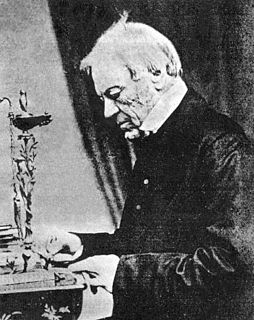
Sir John Richardson FRS FRSE was a Scottish naval surgeon, naturalist and Arctic explorer.

Richardson's ground squirrel, also known as the dakrat or flickertail, is a North American ground squirrel in the genus Urocitellus. Like a number of other ground squirrels, they are sometimes called prairie dogs or gophers, though the latter name belongs more strictly to the pocket gophers of family Geomyidae, and the former to members of the genus Cynomys.
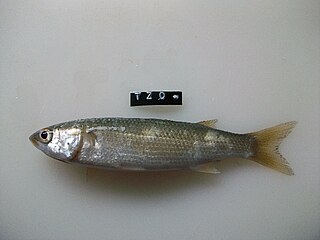
The South African mullet, also called a harder mullet or simply harder, is a species of mullet. It is found in South African coastal waters from Walvis Bay (Namibia) to KwaZulu-Natal, and grows to a maximum length of 40.5 cm. The person the specific name honours was not recorded by Andrew Smith when he described this species but it is most likely to be John Richardson (1787-1865), the Scottish naturalist, surgeon and Arctic explorer.
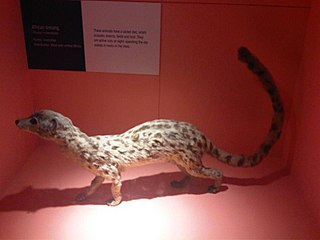
The Central African oyan, also called Central African linsang, is a linsang species native to Central Africa.
Redcar Field is a Site of Special Scientific Interest in the Darlington district of County Durham, England. It is situated just north of Darlington, about 1 km south of the village of Coatham Mundeville.

Coppermine Peninsula is the 1.7 km long, 500 m wide and rising to 105 m rugged rocky promontory forming the northwest extremity of Alfatar Peninsula and Robert Island in the South Shetland Islands, Antarctica and lying between English Strait to the west and Carlota Cove to the east. It is linked to Alfatar Peninsula to the southeast by a narrow isthmus bounded by Carlota Cove to the north and the 1 km wide and 460 m indenting Coppermine Cove to the south. The feature is named in association with the adjacent Coppermine Cove, a descriptive name given by sealers in about 1821 from the copper-coloured staining of the lavas and tuffs in the area.

Anemonastrum richardsonii, commonly known as yellow thimbleweed, is named after a Scottish naturalist, Sir John Richardson (1787–1865) who found it on Franklin's expedition to the Arctic. It is a perennial, deciduous plant that blooms in mid to early June.

Calliergon cordifolium is a species of moss in the Calliergonaceae family, commonly known as the calliergon moss or heart-leaved spearmoss. The species is abundant in the right habitat, and grows in marshes and wet woodland, especially woodland of alder (Alnus) or willow (Salix), as well as around streams, ditches and pools. The species grows in tufts among other moss species. Calliergon cordifolium requires a wet environment to grow, and often grows completely submerged in water. It typically prefers lowland, but has been recorded as high as 910 metres (1,000 yd) above sea level in Inverness, Scotland. The species has a circumpolar Boreo-temperate distribution. It is found throughout Europe. It has been recorded in north and central Asia, as well as Turkey and Japan, throughout North America and in New Zealand.

Calliergon is a genus of moss in the Hypnales order. The species in the genus are commonly referred to as calliergon mosses.

Calliergon giganteum, the giant spearmoss, giant calliergon moss, or arctic moss, is an aquatic plant found on lake beds in tundra regions. It has no wood stems or flowers, and has small rootlets instead of roots.
Arctic moss is a common name for several plants and may refer to:
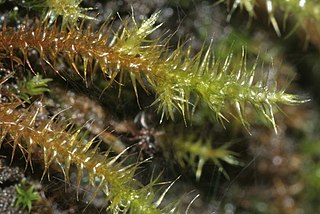
Amblystegiaceae is a family of mosses. It includes 20 to 30 genera with a total of up to 150 species. They occur nearly worldwide, growing in tropical, temperate, and subpolar regions.

Sphaerodactylus richardsonii, also known commonly as Richardson's least gecko or the northern Jamaica banded sphaero, is a small species of lizard in the family Sphaerodactylidae. The species is endemic to Jamaica.
Pseudocalliergon trifarium, the three-ranked spear-moss, is a species of moss belonging to the family Amblystegiaceae.
Myron richardsonii, also known as Richardson's mangrove snake, is a species of venomous homalopsid snake native to the marine waters of eastern Indonesia and northern Australia. The specific epithet richardsonii honours Sir John Richardson, collector of the original specimen.
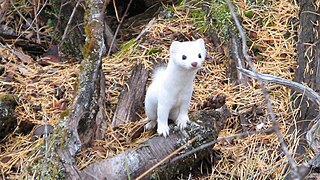
The Haida ermine is a mustelid species endemic to a few islands off the Pacific Northwest of North America, namely Haida Gwaii in Canada and the southern Alexander Archipelago in the U.S. state of Alaska.

The American ermine or American stoat is a species of mustelid native to most of North America.












